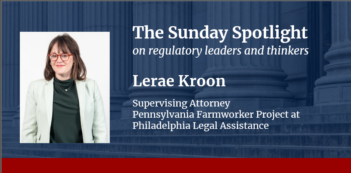
Firms have moral obligations to those who perform work regardless of employment status.
What do platforms like Uber, Airbnb, and TaskRabbit owe to their drivers, hosts, and “taskers?”
Debates on the subject involve a lot of talking past one another. Those inclined to answer “not much” point to the fact that platform laborers have greater flexibility than traditional employees, and therefore can be described as independent entrepreneurs. On the other hand, labor advocates argue that many platform laborers are just as dependent on the platforms as any traditional employee is dependent on an employer, and therefore the workers are just as subject to exploitation. The former group sees no reason to extend employment protections to platform laborers, while others in the latter camp argue that platform laborers are simply another kind of “employee” and should receive all of the same employment protections.
Even those of us seeking a middle-ground approach are stuck wrestling with a word—“employee”—that does not fit new situations well. Better concepts are needed to talk about gig economy workers and other laborers who are subject to the arbitrary domination of powerful companies but who do not fit neatly into traditional understandings of employees.
We suggest a new approach for characterizing this kind of work, which we call “labor without employment.”
The problem with the word “employee,” and its corollary “employer,” is that their legal definitions derive from a New Deal-era understanding of the workplace, when the first major labor and employment statutes were passed. Notwithstanding the variety of legal definitions, the dominant way of thinking about the word “employee” in the United States involves the kind of direct employer control that was ubiquitous in post-industrial revolution workplaces.
But the modern workplace is a very different place. The proliferation of subcontracting, franchising, independent contractor misclassification, and other types of workplace “fissuring,” have forced regulators to wrestle with the legal and normative boundaries of labor and employment law. These new practices have strained the definition of “employee.”
Gig economy relationships present a different challenge to our ideas about employment. Twentieth-century economists contended that employment within the firm was characterized by the entrepreneurial employer directing activity of workers. The idea was that the employer-employee hierarchy within a firm can reduce the transaction costs of market interactions by “superseding” the price mechanism, which markets use to coordinate activity, in favor of entrepreneurial command.
What makes platforms distinct is their use of mobile technology to reduce transaction costs while still using prices to coordinate activity. Platforms wield power over laborers primarily through a form of price-mediated transaction—that is, offering a price to incentivize a worker to do some particular task, rather than compelling them to do it through direct managerial order.
This market-like relationship does not mean that, as some suggest, platform companies do not have moral obligations, or that they should not be subject to regulation. Quite the contrary. Even though platforms do not tell laborers which tasks to perform each day, they do control the availability of tasks and their profitability. Especially as they grow in power and market share, platforms dominate the economic lives of the laborers who depend on them. Uber should be concerned with the living standards of its drivers. Airbnb should be concerned with the safety of its hosts.
Furthermore, asymmetries in information and bargaining power between platforms and laborers could result in platforms taking advantage of laborers’ structurally vulnerable positions. This outcome has been referred to as “justice failure”—unethically making profit through the exacerbation of extant injustice. Given this power imbalance, gig economy laborers are just as deserving of legal protection as traditional employees and gig economy businesses have moral obligations to treat them accordingly.
Unfortunately, traditional labor and employment law is not well suited to the task, forged as it was in the gauntlet of early 20th-century labor movements when transaction costs were much higher, and employment in large firms was the only plausible way to be hired as a laborer.
In most cases, gig economy laborers have been considered independent contractors under the law, and therefore not subject to the legal protections provided to employees. There may be good arguments that, in specific cases, gig economy workers are actually employees of a platform under existing laws because of a high degree of direction and control by the platform. But so far these cases are the minority, and platforms may simply learn from them how to avoid employment law liability in the future.
We suggest a new approach: labor without employment. The United States does not need to rely exclusively on the concept of employment to define the nature of a firm’s moral obligations. Even though platform laborers are organized primarily through prices rather than direct orders, these prices are established by one firm, thus making these workers vulnerable to that firm’s unilateral power. If the United States is committed to protecting labor from potential abuses, “laborers without employment” require protections and privileges similar to those of traditional employees on issues like workplace safety, wages, and invidious discrimination, among others.
But laborers without employment may also deserve protections that traditional employees do not. To illustrate: A limousine business simply directing its drivers to go to the airport to bring an anonymous passenger to a not-yet-specified destination is not, on its own, objectionable—it is acceptable for an employer to direct its employees’ activities.
But if a platform ridesharing app like Uber acts similarly, and does not share information about the passenger or the destination with the driver, this seems problematic. Why? Because the transaction, and the ongoing work relationship between Uber and its driver, is predicated on the Uber driver having the relevant information needed to make a voluntary decision based on the price, not simply receiving a direction from a boss.
Regulation may be necessary, not only to protect laborers from unfair employment practices, but also to protect them from unfair market exchanges. Laborers without employment should be entitled to transparency in pricing and symmetry in information, protections distinct from the sorts that traditional employees require.
Regulators are already taking new approaches to regulating platforms without relying on the concept of employment. For example, New York City recently established minimum per-trip payment formulas for platform drivers like Uber and Lyft. These formulas are written to approximate the equivalent value of working for a traditional employer and receiving an hourly wage of $15. By directly regulating the piece-rate wages of platform drivers, instead of requiring a minimum hourly pay rate typically applied to traditional employees, the rule is better adapted to the platform context. It simply limits platforms’ ability to reduce prices to an unacceptable level, without requiring them to exert more direct managerial control over drivers’ use of the app.
As modern workplaces change, and more and more workers are left without needed legal protection, we will need to find ways of protecting labor within the novel contexts of a modern economy. The idea of “labor without employment” can help us with this task.
This essay is part of a nine-part series, entitled The Future of Workplace Regulation.





